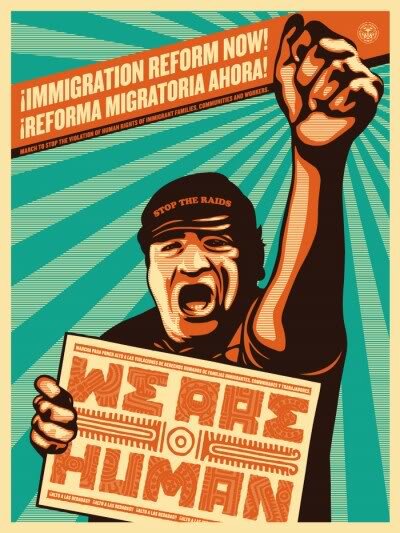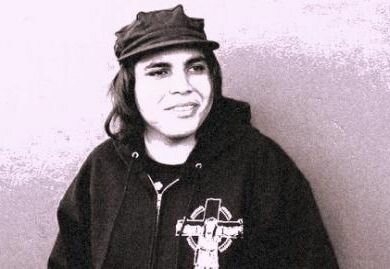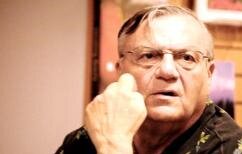Ernesto Yerena: A rising grassroots artistic force
Culture, The Arts — By Eduardo Barraza on March 16, 2010 at 12:30We are Human Fist: Collaboration with Shepard Fairey visit http://hechoconganas.com
This “golden boy” of social art has already created historic images. And he’s just beginning.
For the thousands of people who have participated in recent pro-immigration marches and demonstrations in Arizona, the name Ernesto Yerena is not as popular as some of the posters he has created and which have become an emblematic symbol in the quest for immigration reform.
Not as popular yet, because the name Ernesto Yerena is rising as a powerful wave of artistic and singular grassroots expression. Whoever has seen the impressive artwork of this Los Angeles-based artist, will have to agree that Yerena’s work is exceptional, inspiring and of historic relevance.
Ernesto Yerena, 23, was born in El Centro, California —a city 10 miles away from the U.S.-Mexico border—and was first exposed to painting, colors and art in the backyard of his childhood home. There, his father would become his first teacher.
“My dad is a car painter; he does auto bodywork and painting. When I was a kid, when I was really little —remembers Yerena— he would be working a lot. Then my mom kinda started telling him to start working at home to spend more time with me because he was always working. He started working in my house’s backyard, so I grew up around him while he was painting cars.”
Yerena thus began to be shaped as an artist within this work environment and by his supportive traditional Mexican family. “Around when I was nine years old —he recalls— I kinda of got into painting my stuff. I had an old wagon, a radio flyer, and I painted it red, then and I would draw my name on it and stuff.”
His father showed him how to cut stencils and on his 10th birthday this skill was further encouraged by his grandfather who bought him, as a present, a cutting set that —he says— “really showed me how to cut…” The young Yerena would eventually become interested in art as he went to art school and then to work as an intern for a couple of years.
Yerena’s shaping forces and influences go well beyond this family circle. Growing up in the El Centro-Calexico-Mexicali area, the particular socioeconomic aspects of this United States-Mexico border region had an effect on his formative process. Eventually, this would turn him into an artist concerned with social issues.
“I grew up in the border and I spent the first five, six years of my life with my grandma,” evokes Yerena. “I was pretty much like the typical Mexican kid. I didn’t even know English. By the time kindergarten came around, I started getting into school, learning English, and trying to become more Americanized as I grew older.”
Then another birthday present, now coming from his dad, would stir up his social conscience. Around the same time Microsoft Windows 95 first came up in the market, the younger Yerena got his first personal computer. “The computer came with an Encarta [Encyclopedia] CD —said Yerena— and it had like four songs; one of them was like country music, The Beatles, but my favorite song was by Public Enemy. It was very social and it talked about what’s going on in the Black communities, the ghettos and all that. From there I also kinda listened to [Mexican rock band] Mana sometimes, and all these guys were talking about social struggles and what’s going on in the world, I guess.” His social and political vision expanded later as the list of musical influences grew to include Rage Against the Machine —an American rock
band— and Los Tigres del Norte —a Mexican norteño band.
Yerena’s bicultural and bilingual influences with music made him realize his place in geography and taught him practical lessons in language and culture. “From there I was like, I feel like I am in the middle, I was pretty young when I kinda noticed that I lived in the border. Every time I gotta go visit my grandma I gotta wait an hour in line. Then I go over there and I am American and I stay here and I am Mexican. It’s kind like an identity crisis, what I am?, whom am I going to identify with? I was always trying to kinda balance myself out so I wouldn’t freak out as much, you know.”
To top off all these shaping elements, Yerena then started looking into history. “People like Cesar Chavez… Malcolm X… MLK… Che Guevara…” And so Ernesto Yerena found a wide grassroots avenue to speak through art, “not for big corporations but for the little man I guess,” he reveals.
Yolie Hernandez contributed to this interview.
More stories about Ernesto Yerena




 Share This
Share This Tweet This
Tweet This Digg This
Digg This Save to delicious
Save to delicious Stumble it
Stumble it






 Sheriff Joe Arpaio challenges march in Washington with largest crackdown on undocumented in Arizona
Sheriff Joe Arpaio challenges march in Washington with largest crackdown on undocumented in Arizona Hundreds of students, supporters from L.A. demand to Veto SB 1070
Hundreds of students, supporters from L.A. demand to Veto SB 1070







